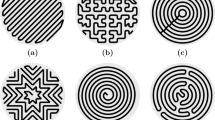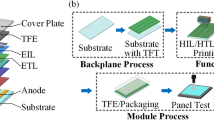Abstract
In nozzle-based three-dimensional printing, transitions are movements of the printing nozzle from a path endpoint to a path start-point. These transitions diminish printing quality by causing strings. A method to minimize the number of transitions based on direction-parallel line segments is presented in this paper. The endpoints of line segments were considered to be “cities” in converting the problem of minimizing the number of transitions into a traveling salesman problem (TSP). A genetic algorithm solver was developed by designing an oriented mutation method for the TSP. Compared with other algorithms for solving the TSP, our algorithm generates paths with fewer transitions. The algorithm was tested using several fused-deposition-modeling and weld arc additive manufacture examples to confirm that the generated paths were reasonable.





















Similar content being viewed by others
References
Abdulhameed, O., Abdulrahman, A., & Wadea, A. (2019). Additive manufacturing: Challenges, trends, and applications. Advances in Mechanical Engineering, 11, 1–27. https://doi.org/10.1177/1687814018822880.
Ho, C. M. B., Ng, S. H., & Yoon, Y. J. (2015). A review on 3D printed bioimplants. International Journal of Precision Engineering and Manufacturing, 16(5), 1035–1046.
Kim, J., Caire, G., & Molisch, A. F. (2015). Quality-aware streaming and scheduling for device-to-device video delivery. IEEE/ACM Transactions on Networking, 24(4), 2319–2331.
Chiaroni, A. B., & Silveira, Z. C. (2019). Experimental and numerical evaluation of the temperature profile of a modular extrusion head applied to an experimental 3D printer. The International Journal of Advanced Manufacturing Technology, 103(9), 4385–4398.
Qi, L., Yi, H., Luo, J., Zhang, D., & Shen, H. (2020). Embedded printing trace planning for aluminum droplets depositing on dissolvable supports with varying section. Robotics and Computer-Integrated Manufacturing, 63, 101898.
Yi, H., Qi, L., Luo, J., Zhang, D., Li, H., & Hou, X. (2018). Effect of the surface morphology of solidified droplet on remelting between neighboring aluminum droplets. International Journal of Machine Tools and Manufacture, 130–131, 1–11. https://doi.org/10.1016/j.ijmachtools.2018.03.006.
Diourté, A., Bugarin, F., Bordreuil, C., & Segonds, S. (2021). Continuous three-dimensional path planning (CTPP) for complex thin parts with wire arc additive manufacturing. Additive Manufacturing, 37, 101622. https://doi.org/10.1016/j.addma.2020.101622.
Woo, Y. Y., Han, S. W., Oh, I. Y., Moon, Y. H., & Ha, W. (2019). Control of directed energy deposition process to obtain equal-height rectangular corner. International Journal of Precision Engineering and Manufacturing, 20(12), 2129–2139.
Kim, M. K., Lee, I. H., & Kim, H. C. (2018). Effect of fabrication parameters on surface roughness of FDM parts. International Journal of Precision Engineering and Manufacturing, 19(1), 137–142.
Zhang, L., Ding, L., Ullah, S., Hu, T., Xu, Y., Chen, L., & Hanif, M. (2020). An improved medial axis path generation algorithm for selective laser melting. Rapid Prototyping Journal, 26, 1751–1759.
Jin, Y. A., He, Y., Fu, J. Z., Gan, W. F., & Lin, Z. W. (2014). Optimization of tool-path generation for material extrusion-based additive manufacturing technology. Additive manufacturing, 1, 32–47.
Aiyiti, W., Xiang, J., & Zhang, L. (2012). Study on the veritable parameters filling method of plasma arc welding based rapid prototyping. Key Engineering Materials, 522, 110–116.
Li, J. Z., Alkahari, M. R., Rosli, N. A. B., Hasan, R., Sudin, M. N., & Ramli, F. R. (2019). Review of wire arc additive manufacturing for 3D metal printing. International Journal of Automation Technology, 13(3), 346–353.
Tabernero, I., Paskual, A., & Alvarez, P. (2018). Study on arc welding processes for high deposition rate additive manufacturing. Pro CIRP, 68, 358–362. https://doi.org/10.1016/j.procir.2017.12.095.
Rios, S., Colegrove, P., & Martina, F. (2018). Analytical process model for wire arc additive manufacturing. Additive Manufacturing, 21, 651–657. https://doi.org/10.1016/j.addma.2018.04.003.
Mukherjee, T., Zhang, W., & DebRoy, T. (2017). An improved prediction of residual stresses and distortion in additive manufacturing. Computational Materials Science, 126, 360–372.
Kuo, C. C., & Yang, X. Y. (2020). Optimization of direct metal printing process parameters for plastic injection mold with both gas permeability and mechanical properties using design of experiments approach. The International Journal of Advanced Manufacturing Technology, 109(5), 1219–1235.
Ganganath N, Cheng C, Fok K (2016) Trajectory planning for 3D printing: A revisit to traveling salesman problem. In: Wong T (ed) 2nd International Conference on Control, Automation and Robotics. Springer, New York. pp 287–290. http://doi.org/https://doi.org/10.1109/ICCAR.2016.7486742.
Luo R, Tseng P (2017) Trajectory generation and planning for simultaneous 3D printing of multiple objects. In: Eric M (ed) IEEE 26th International Symposium on Industrial Electronics, IEEE, New York. pp 1147–1152. http://doi.org/https://doi.org/10.1109/isie.2017.8001407.
Wah, P., Murty, K., & Joneja, A. (2002). Tool path optimization in layered manufacturing. IIE Transactions, 34, 335–347. https://doi.org/10.1023/A:1012839601085.
Piotr L, Leszek K, Iwona P (2016) Path optimization in 3D printer: Algorithms and experimentation system. In: IEEE Staff (ed) 4th International Symposium on Computational and Business Intelligence. IEEE, Olten. pp 137–142. http://doi.org/https://doi.org/10.1109/ISCBI.2016.7743272.
Wang, X., Wang, A., & Li, Y. (2019). A sequential path-planning methodology for wire and arc additive manufacturing based on a water-pouring rule. The International Journal of Advanced Manufacturing Technology, 103(9), 3813–3830.
Choi, M., Wu, C., & Kim, J. W. (2020). Numerical optimization of the welding sequence for mitigating welding deformation in aluminum pipe structures by using a genetic algorithm. International Journal of Precision Engineering and Manufacturing, 21(12), 2323–2333.
Thompson, B., & Yoon, H. S. (2014). Efficient path planning algorithm for additive manufacturing systems. IEEE Transactions on components, packaging and manufacturing technology, 4(9), 1555–1563.
Pezer, D. (2016). Efficiency of tool path optimization using genetic algorithm in relation to the optimization achieved with the CAM software. Procedia Engineering, 149, 374–379.
Karuppusamy, N., & Kang, B. (2017). Minimizing airtime by optimizing tool path in computer numerical control machine tools with application of A* and genetic algorithms. Advances in Mechanical Engineering, 9, 1–9. https://doi.org/10.1177/1687814017737448.
Han, W., Jafari, M. A., Danforth, S. C., & Safari, A. (2002). Tool path-based deposition planning in fused deposition processes. Journal Manufacturing. Science Engineering, 124(2), 462–472.
Liu, W., Chen, L., Mai, G., & Song, L. (2020). Toolpath planning for additive manufacturing using sliced model decomposition and metaheuristic algorithms. Advances in Engineering Software, 149, 102906. https://doi.org/10.1016/j.advengsoft.2020.102906.
Nayak, R., Bahubalendruni, R., & Biswal, B. (2016). An approach towards economized 3D printing. Applied Mechanics and Materials, 852, 185–191.
Panda, B. N., Bahubalendruni, R. M., Biswal, B. B., & Leite, M. (2017). A CAD-based approach for measuring volumetric error in layered manufacturing. Proceedings of the Institution of Mechanical Engineers, Part C: Journal of Mechanical Engineering Science, 231(13), 2398–2406.
Fok K, Cheng C, Tse C (2016) A relaxation scheme for TSP-based 3D printing path optimizer. In: Qian Y (ed) International Conference on Cyber-Enabled Distributed Computing & Knowledge Discovery. KeAi Publishing LTD, London. pp 382–385. http://doi.org/https://doi.org/10.1109/CyberC.2016.80.
Perez D (2010) Solving an arc-routing problem using artificial ants with a graph transformation. In: Advances in Practical Applications of Agents and Multiagent Systems, Toledo. pp.241–246. http://doi.org/https://doi.org/10.1007/978-3-642-12384-9_29.
Pan J, Wang D (2006) An ant colony optimization algorithm for multiple travelling salesman problem. In: IEEE Staff (ed) First International Conference on Innovative Computing, Information and Control, IEEE, New York. pp 210–213. http://doi.org/https://doi.org/10.1109/ICICIC.2006.40.
Tewolde, G. S., & Sheng, W. (2008). Robot path integration in manufacturing processes: Genetic algorithm versus ant colony optimization. IEEE Transactions on Systems, Man, and Cybernetics-Part A: Systems and Hssumans, 38(2), 278–287.
Alhamdy, S., Noudehi, A., & Majdara, M. (2012). Solving traveling salesman problem using ants colony algorithm and comparing with Tabu search, simulated annealing and genetic algorithm. Journal of Applied Sciences Research, 8, 430–440.
Afaq, H., & Saini, S. (2011). On the solutions to the travelling salesman problem using nature inspired computing techniques. International Journal of Computer Science Issues (IJCSI), 8(4), 326.
Gao, W. (2016). Improved ant colony clustering algorithm and its performance study. Computational Intelligence and Neuroscience, 16, 1–14.
Li T, Shao G, Zuo W (2017) Genetic algorithm for building optimization - state-of-the-art survey. In: Jayaweera N (ed) Proceedings of 9th International Conference on Machine Learning and Computing, Association for Computing Machinery, New York. pp.205–210.
Lee, C. (2018). A review of applications of genetic algorithms in operations management. Engineering Applications of Artificial Intelligence, 76, 1–12. https://doi.org/10.1016/j.engappai.2018.08.011.
Mavrovouniotis, M., & Yang, S. (2011). A memetic ant colony optimization algorithm for the dynamic travelling salesman problem. Soft Computing, 15, 1405–1425. https://doi.org/10.1007/s00500-010-0680-1.
Dorigo, M., Birattari, M., & Thomas, S. (2006). Ant colony optimization. IEEE Computational Intelligence Manufacturing, 35, 28–39. https://doi.org/10.1109/MCI.2006.329691.
Wang, Y. (2014). The hybrid genetic algorithm with two local optimization strategies for traveling salesman problem. Computers and Industrial Engineering, 70, 124–133. https://doi.org/10.1016/j.cie.2014.01.015.
Liu, F., & Zeng, G. (2009). Study of genetic algorithm with reinforcement learning to solve the TSP. Expert Systems with Applications, 36, 6995–7001. https://doi.org/10.1016/j.eswa.2008.08.026.
Lin, B. L., Sun, X., & Salous, S. (2016). Solving travelling salesman problem with an improved hybrid genetic algorithm. Journal of computer and communications., 4(15), 98–106.
Lin, C. J., & Lin, C. H. (2019). An adaptive-group-based differential evolution algorithm for inspecting machined workpiece path planning. The International Journal of Advanced Manufacturing Technology, 105(5), 2647–2657.
Yang, J., Shi, X., & Marchese, M. (2008). An ant colony optimization method for generalized TSP problem. Progress in Natural Science, 18, 1417–1422. https://doi.org/10.1016/j.pnsc.2008.03.028.
Yoon, H., & Moon, N. (2002). An empirical study on the synergy of multiple crossover operations. IEEE Transaction on Evolutionary Computation, 6, 212–223. https://doi.org/10.1109/4235.996022.
Choi, I., Kim, S., & Kim, H. (2003). A genetic algorithm with a mixed region search for a mixed region search for the asymmetric traveling salesman problem. Computers and Operations Research, 30, 773–786. https://doi.org/10.1016/s0305-0548(02)00050-3.
Liang, Y., Ge, H., & Zhou, C. (2003). Solving traveling salesman problem by genetic algorithms. Progress in Natural Science, 13, 135–141. https://doi.org/10.1080/10020070412331344061.
Acknowledgments
This project was supported by the National Natural Science Foundation of China (Grant No. 51975281 and 51705183). Metal workpieces were fabricated using the WAAM method by the Jiangsu Jiuyu Machinery Limited Company. Qingdao JointX Intelligent Manufacturing Ltd. produced the WAAM workpiece shown in Fig. 20b.
Author information
Authors and Affiliations
Corresponding author
Additional information
Publisher's Note
Springer Nature remains neutral with regard to jurisdictional claims in published maps and institutional affiliations.
Rights and permissions
About this article
Cite this article
Liu, H., Liu, R., Liu, Z. et al. Minimizing the Number of Transitions of 3D Printing Nozzles Using a Traveling-Salesman-Problem Optimization Model. Int. J. Precis. Eng. Manuf. 22, 1617–1637 (2021). https://doi.org/10.1007/s12541-021-00512-2
Received:
Revised:
Accepted:
Published:
Issue Date:
DOI: https://doi.org/10.1007/s12541-021-00512-2




